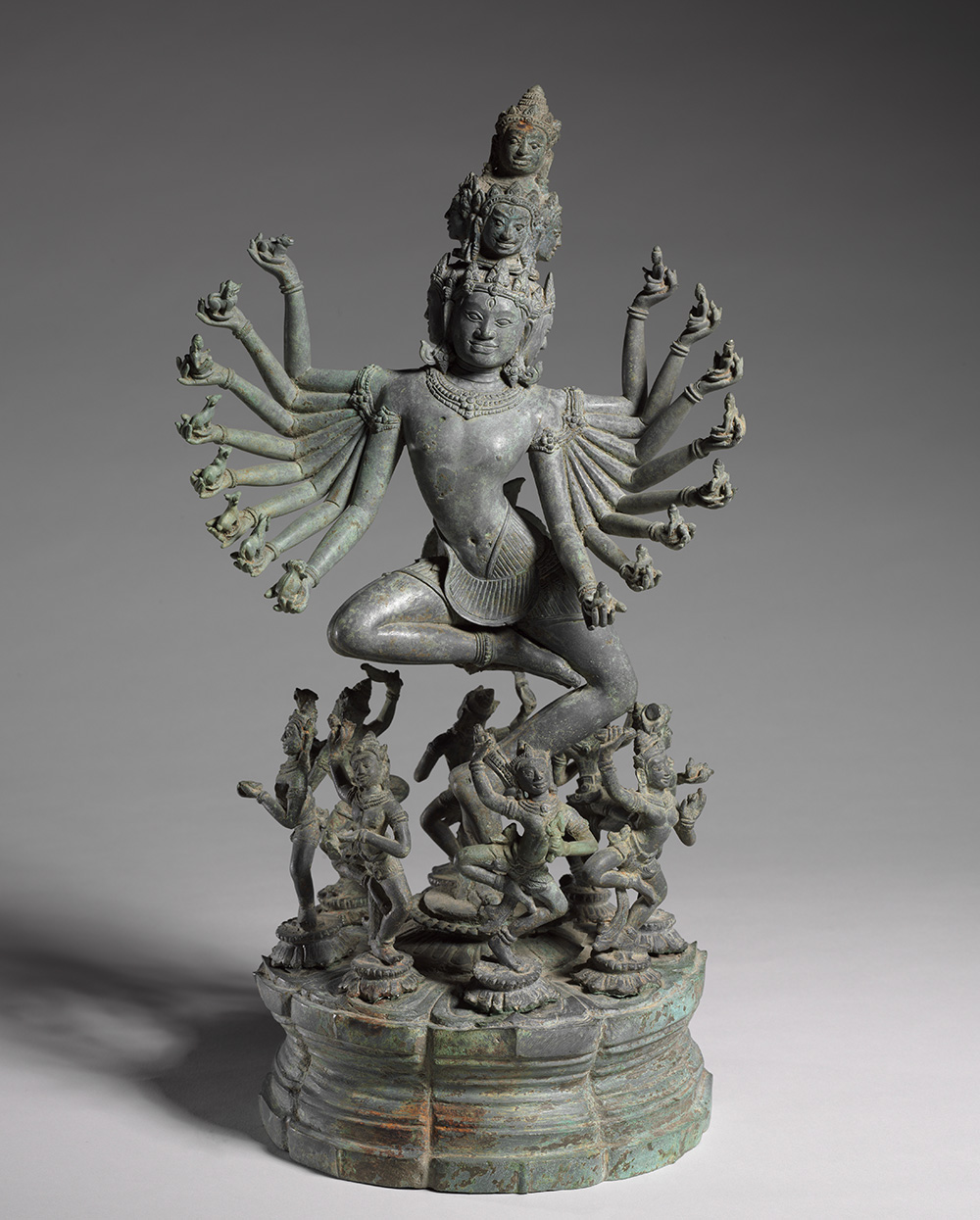
Dancing Hevajra Surrounded by Dancing Yoginis, circa 1050–1100, northeastern Thailand; former kingdom of Angkor, bronze, Cleveland Museum of Art, gift of Maxeen and John Flower in honor of Dr. Stanislaw Czuma, 2011.143, 18 1/8 x 9 7/16 in. (46 x 23.9 cm)
Verbal Description
Hello, my name is Kamellia Smith. I am community partner of the Cincinnati Art Museum. I will be reading the verbal description for Dancing Hevajra Surrounded by Dancing Yoginis in Beyond Bollywood: 2000 Years of Dance in Art.
From northeastern Thailand’s former kingdom of Angkor, this Dancing Hevajra Surrounded by Dancing Yoginis bronze sculpture dates from circa 1050 to 1100. It is in the collection of the Cleveland Museum of Art and is a gift of Maxeen and John Flower in honor of Dr. Stanislaw Czuma. The accession number is 2011.143.
This bronze sculpture of Dancing Hevajra Surrounded by Dancing Yogini’s stands at 46 centimeters tall and 23.9 centimeters wide. It has a gray-green patina. Hevajra’s eight heads are represented as three tiers of heads that get smaller towards the top. The largest set at the bottom consists of one head at the center that looks straight ahead and two on either side looking in opposite directions. The next set consists of one at the center, two at the sides, and another at the back. The single, smallest head at the top is adorned with a tiered, conical crown wrapped around the figure’s forehead. The additional heads wear tiara-like crowns. Each face makes a slightly different expression. All but the top head have an oblong third eye at the center of the forehead and elongated earlobes with earrings—some with floral motifs.
Hevajra is bare chested. A jeweled necklace with a floral motif at the center adorns his neck. He also wears bracelets, armlets, and anklets. From his shoulders sprout sixteen arms—eight on either side—each rising towards his heads. He holds skull cups in his open palms. In his left hands, within the cups, are seated figures in meditative postures. In his right hands he holds several animals. From top right hand to bottom: a bull, lion, human, cat, camel, sheep, horse, and elephant.
A pleated garment is wrapped around his waist, hitting at his upper thighs. He balances on the bent toes of his left feet. His left knees are gently bent. His right feet are flat against his left inner thighs and his right knees are bent. He balances on a circular disc, under which the arms and legs of a human corpse are slightly visible on either side. The corpse is laid flat at the center of an eight-petaled lotus flower. Within each of the petals are eight figures dancing on smaller lotus flowers in a ring around Havajra. These figures mirror the position of Havajra’s legs, yet each figure has just two legs and two arms; they hold their right arms up, left arms down, with various implements in their hands. All the figures balance on a round base that steps in and out like an hourglass.
Label Text
Hello, my name is Kamellia Smith. I am community partner of the Cincinnati Art Museum. I will be reading the label for Dancing Hevajra Surrounded by Dancing Yoginis in Beyond Bollywood: 2000 Years of Dance in Art.
From northeastern Thailand’s former kingdom of Angkor, this Dancing Hevajra Surrounded by Dancing Yoginis bronze sculpture dates from circa 1050 to 1100. It is in the collection of the Cleveland Museum of Art and is a gift of Maxeen and John Flower in honor of Dr. Stanislaw Czuma. The accession number is 2011.143
In a three-dimensional realization of the mandala of Hevajra, the god dances on a demonic corpse embodying delusion and fear. Mandalas are diagrams for meditation and visualization that often resemble the ground plan of a palace, with deities arranged in patterns. Following the symbolism of the Hevajra Tantra, the key text for understanding the nature, powers, and symbolism of the god, eight dancing yoginis surround Hevajra.
Angkor—an empire that included present-day Cambodia and parts of Thailand and Vietnam—had long been in touch with centers of religious learning in India, and a version of the Hevajra Tantra was known there. However, while several related artworks survive, scholars have not worked out the details of how the Hevajra cult in Angkor functioned.
